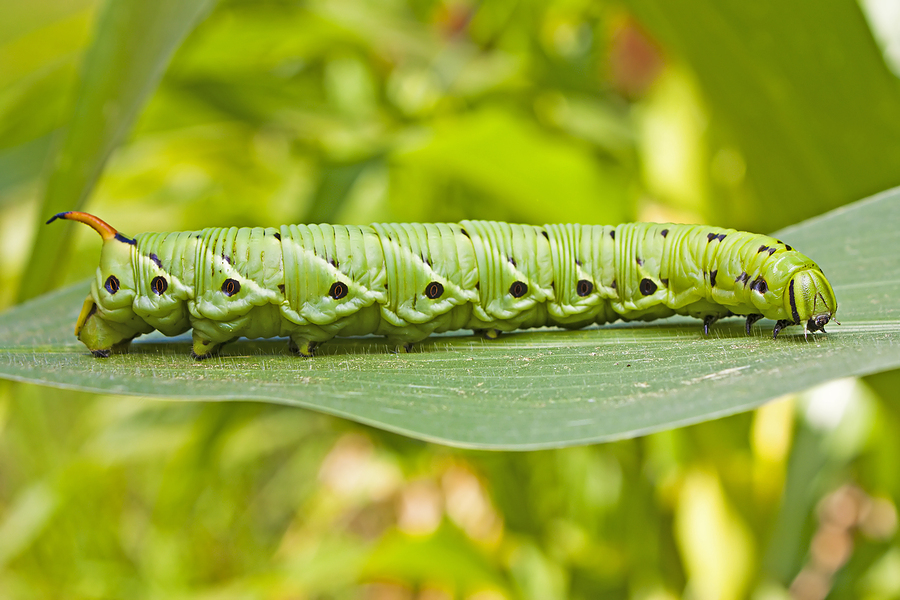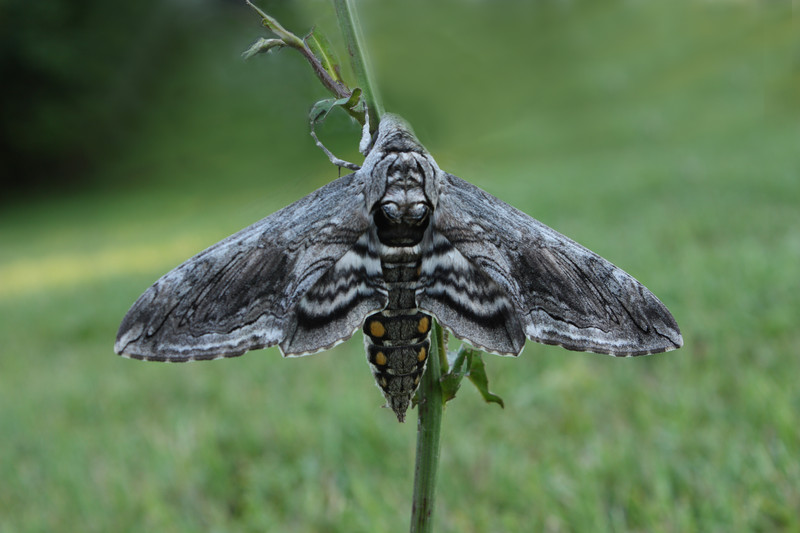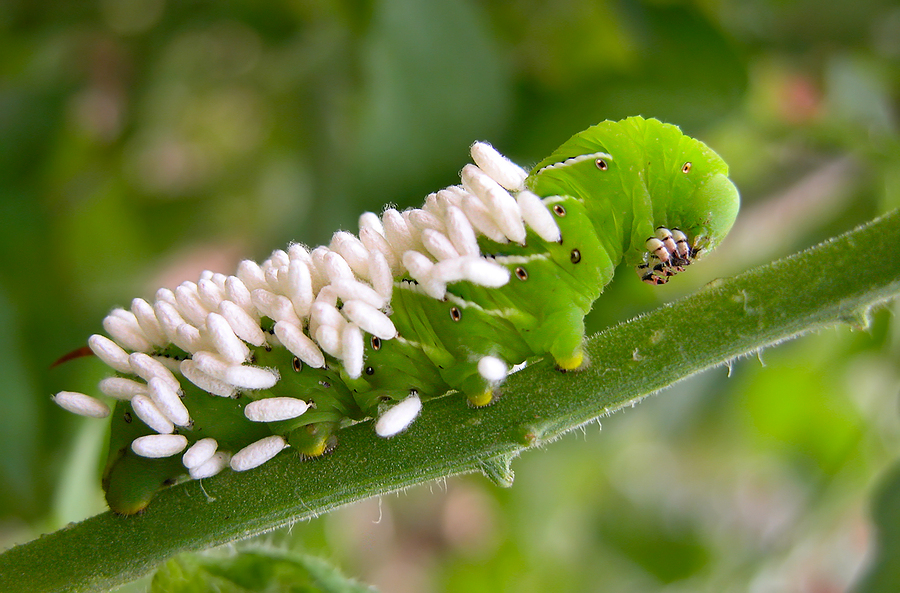Tomato hornworms are green caterpillars up to 4½ inches long with a black horn protruding from the tail and eight V-shaped white marks along the side.
A related hornworm is a tobacco hornworm with a red horn on the tail and seven white diagonal lines with a black border.
Hornworms feed on leaves, stems, and fruit of nightshade family plants—tomatoes, eggplants, potatoes, peppers, and others. Feeding hornworms can kill plants.
Hornworms are the larvae of large, gray moths with wingspans of 4 to 5 inches.
Good Products for Pest and Disease Control at Amazon:
- Garden Safe Snail and Slug Bait
- Bonide Sulfur Fungicide
- Monterey BT Caterpillar Killer
- Neem Bliss 100-% Cold Pressed Neem Oil
- Safer Brand Insect Killing Soap
- PyGanic Botanical Insecticide
Hornworms easily blend in with the foliage of the plants they attack but they leave behind black pellets of excrement which are easy to spot. They often feed upside down on the bottom of the leaves.
Moths emerge from soilborne pupae in early summer. Adult moths lay eggs on the underside of leaves. The eggs hatch in a week then the larvae hornworms feed for a month.
Moths lay pale green eggs singly on the leaf undersides. After feeding the caterpillars enter the soil and form brown, shiny, 2-inch-long pupae. The pupae can overwinter. There are four generations a year.

Tomato hornworms eat large, ragged holes in tomato leaves, easily consuming whole leaves. Hornworms also eat stems and green fruit, and if they arrive early enough in the season seedlings and young plants.
Tomato hornworms feed not only on tomatoes but also peppers, eggplants, and potatoes—any member of the nightshade family.
The best way to control tomato hornworms is to handpick them from tomato family plants and crush them. Parasitic wasps released in the garden can also control hornworms.
The tomato hornworm (Manduca quinquemaculata) is a green caterpillar with seven or eight white stripes and a black horn projecting from its rear end. It is the best-known tomato pest and the largest; the hornworm can grow from three to four to five inches long. The tomato hornworm is the larval stage of the five-spotted hawk moth; it too is large with a wingspan of nearly five inches. (A similar species is the tobacco hornworm (Manduca sexta), also green with white stripes, but a red horn jutting from its rear.)
Scientific name: Manduca quinquemaculata (tomato hornworm), Manduca sexta (tobacco hornworm).
Lifecycle of the tomato hornworm
Hawk moths emerge from soilborne pupae in early summer at the start of the tomato gardening season. Adult moths lay eggs on the underside of leaves, and eggs hatch in a week. The larvae—the tomato hornworm–feed for about four weeks then pupate in the soil usually until the following summer. But in long summer regions, there can be two, three, or four generations in a year.

Adult moths
The hawk moth is a mottled grayish or brownish moth with a large, furry body. White zigzags appear on the rear wings and orange or brownish spots on the sides of the abdomen. The hawk moth has long, narrow gray wings and a wingspan of up to 4- to 5 inches. The moth flies mostly at twilight and can hover hummingbird-like in the air to sip nectar from deep-throated flowers. The hawk moth lays eggs on the underside of tomato-family crops and weeds.
Eggs
Hawk moths lay single greenish-yellow eggs on the underside of leaves. The eggs hatch small green caterpillars in about a week.
Larvae
The tomato hornworm is the larval stage of the hawk moth. It is a green caterpillar up to 5 inches long with V-shaped white marks down the sides of the body and a black horn at the tail end. (The related tobacco hornworm is similar but has seven white stripes down the side and a red horn.) The hornworm chews on leaves leaving only the midribs of leaves behind and sometimes chews into green fruit. The hornworm reaches full size after three or four weeks of feeding.
In autumn, hornworms pupate forming a hard shell. The pupae rest in the soil over the winter three or four inches below the surface.

Tomato hornworm controls
Garden cultivation
Early in the garden season, turn the soil where tomato family plants grew the season before. Cultivation will expose hornworm pupae to killing cold and birds.
Handpicking
Handpick caterpillars from foliage. Check tomato-family plants frequently for larvae and handpick them. (Hornworms may look mean, but they will not harm humans.) Remove hornworms from plants and crush them or drown them in soapy water. Do not handpick and destroy parasitized caterpillars; they will hatch beneficial parasitic braconid wasps.
Parasitic wasps
Attract or release parasitic braconid wasps into the garden. Braconid wasps lay eggs on caterpillars, often forming small white cocoons on the skin. When the wasp eggs hatch, the larvae feed on hornworms. Trichogramma wasps parasitize hornworms in the egg stage.
Bacterium sprays
Spray small caterpillars with Bt, Bacillus thuringiensis, a pathogenic bacterium (safe for man). Spinosad (a bacterium-based insecticide) can also control hornworms.
Repellant plants
Plant borage, marigold, or opal basil in the garden. These plants repel hawk moths and hornworms.
Summary of organic controls
Handpicking is perhaps the most effective; handpick and drown in soapy water. Apply Bacillus thuringiensis (Bt) while caterpillars are still small. Pyrethrum, rotenone, and spinosad sprays are the most toxic and last resort, but these sprays also kill beneficial insects.
Organic control calendar
Here’s what you can do seasonally to control tomato hornworms:
- Before planting: Turn soil 3 to 5 inches to expose overwintered pupae; they will die in the cold or be eaten by birds.
- At planting time: Give the soil final shallow cultivation to expose pupae. Plant dill as a trap crop to draw moths and hornworms away from the main crop.
- While crops develop: Handpick caterpillars from foliage and destroy them. Repel hornworms with hot pepper spray; spray the solution directly on the pest. Apply Bt or spinosad when caterpillars are small. Attract braconid wasps to the garden; female braconid wasps lay eggs under the skin of hornworms; when the wasp eggs hatch the larvae feed on the hornworm literally eating hornworms alive. Leave parasitized hornworms in the garden to allow new generations of braconid wasps to appear.
- After harvest: Remove old plants and overgrown weeds. Turn soil 4 to 6 inches deep to expose pupae to cold and birds.
Natural predators
Braconid and trachogramma wasps are small wasps that parasitize hornworms. Other insect predators are assassin bugs and praying mantids. Animal predators include orioles, barn swallows, blackbirds, bluebirds, downy woodpeckers, flycatchers, phoebes, and sparrows, also moles, skunks, and toads.
Related articles:
Vegetable Garden Organic Pest Control
Vegetable Garden Diseases Problem Solver
Vegetable Garden Organic Weed Control
Garden Planning Books at Amazon:
- Vegetable Garden Almanac & Planner
- Kitchen Garden Grower’s Guide Vegetable Encyclopedia
- Vegetable Garden Grower’s Guide
- Tomato Grower’s Answer Book
Tomato articles at Harvest to Table:
How to Plant and Grow Tomatoes
How to Choose a Tomato for Your Garden
Growing Tomatoes in Containers
Growing Early Season Tomatoes for Great Taste
Epsom Salt, Milk, and Organic Fertilizers for Tomatoes and Peppers
How to Prevent Blossom Drop – Tomatoes and Peppers
How to Harvest and Store Tomatoes
Nine Ways to Cook and Serve Tomatoes
Tomato Sauce–Basic, Herbed, or Vegetables Added
How to Make Tomato Juice Simply
How to Home Can Tomatoes for Beginners
How to Sun Dry and Oven Dry Tomatoes
Tomato Growing Problems Troubleshooting
How to Prevent Tomato Blossom Drop
How to Identify Early Blight, Late Blight, and Leaf Spot
Tomato Hornworm Organic Pest Control















